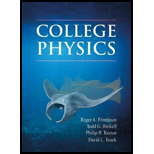
Concept explainers
(a)
The definition of term baryon.
Explanation of Solution
A baryon is defined as a composite subatomic particle which is made up of three quarks. Since protons and neutrons are the most stable baryons, so most building blocks of matter are baryons.
(b)
The definition of term meson.
Explanation of Solution
Mesons are defined as an intermediate mass particle which consists of a pair of quark and antiquark. Three combinations of quarks are termed as baryons. Mesons are bosons, and fermions are the baryons. There was a recent claim that particles with five quarks (pent quarks) were observed, but further experiments did not support it.
(c)
The definition of term quark.
Explanation of Solution
Quark is a type of elementary particle which is a fundamental constituent of matter. These are combined to form a composite particle known as hadrons. The properties of quark are spin, mass, color charge, and electric charge. Quark is of 6 types termed as flavors. They are up, charm, strange, down, bottom and top quarks. The two quarks, up and down, have lowest masses as well as they are most stable amongst all. Each quark flavor has its antiparticle, termed as antiquark. So, these can be replaced by their corresponding antiquarks.
(d)
The definition of term lepton.
Explanation of Solution
A lepton is defined as an elementary particle. They do not involve in strong interactions, but these have a half-integer spin equal to
- Charged leptons.
Charged leptons when combined with other particles, form different composite particles like atoms and positronium.
(e)
The definition of term antiparticle.
Explanation of Solution
In particle physics, there is an antiparticle for each particle type with the same mass but opposite physical charges like electric charge. Consider an electron. The electron antiparticle is an anti-electron which is also termed as positron. Since the electric charge on electron is negative, so the charge on positron will be positive. Thus, it is produced naturally in various types radioactive decays.
Want to see more full solutions like this?
Chapter 28 Solutions
COLLEGE PHYSICS
- A man slides two boxes up a slope. The two boxes A and B have a mass of 75 kg and 50 kg, respectively. (a) Draw the free body diagram (FBD) of the two crates. (b) Determine the tension in the cable that the man must exert to cause imminent movement from rest of the two boxes. Static friction coefficient USA = 0.25 HSB = 0.35 Kinetic friction coefficient HkA = 0.20 HkB = 0.25 M₁ = 75 kg MB = 50 kg P 35° Figure 3 B 200arrow_forwardA golf ball is struck with a velocity of 20 m/s at point A as shown below (Figure 4). (a) Determine the distance "d" and the time of flight from A to B; (b) Determine the magnitude and the direction of the speed at which the ball strikes the ground at B. 10° V₁ = 20m/s 35º Figure 4 d Barrow_forwardThe rectangular loop of wire shown in the figure (Figure 1) has a mass of 0.18 g per centimeter of length and is pivoted about side ab on a frictionless axis. The current in the wire is 8.5 A in the direction shown. Find the magnitude of the magnetic field parallel to the y-axis that will cause the loop to swing up until its plane makes an angle of 30.0 ∘ with the yz-plane. Find the direction of the magnetic field parallel to the y-axis that will cause the loop to swing up until its plane makes an angle of 30.0 ∘ with the yz-plane.arrow_forward
- A particle with a charge of − 5.20 nC is moving in a uniform magnetic field of (B→=−( 1.22 T )k^. The magnetic force on the particle is measured to be (F→=−( 3.50×10−7 N )i^+( 7.60×10−7 N )j^. Calculate the y and z component of the velocity of the particle.arrow_forwardneed answer asap please thank youarrow_forward3. a. Determine the potential difference between points A and B. b. Why does point A have a higher potential energy? Q = +1.0 C 3.2 cm 4.8 cm Aarrow_forward
 University Physics Volume 3PhysicsISBN:9781938168185Author:William Moebs, Jeff SannyPublisher:OpenStax
University Physics Volume 3PhysicsISBN:9781938168185Author:William Moebs, Jeff SannyPublisher:OpenStax College PhysicsPhysicsISBN:9781938168000Author:Paul Peter Urone, Roger HinrichsPublisher:OpenStax College
College PhysicsPhysicsISBN:9781938168000Author:Paul Peter Urone, Roger HinrichsPublisher:OpenStax College
 Physics for Scientists and Engineers: Foundations...PhysicsISBN:9781133939146Author:Katz, Debora M.Publisher:Cengage Learning
Physics for Scientists and Engineers: Foundations...PhysicsISBN:9781133939146Author:Katz, Debora M.Publisher:Cengage Learning College PhysicsPhysicsISBN:9781305952300Author:Raymond A. Serway, Chris VuillePublisher:Cengage Learning
College PhysicsPhysicsISBN:9781305952300Author:Raymond A. Serway, Chris VuillePublisher:Cengage Learning Principles of Physics: A Calculus-Based TextPhysicsISBN:9781133104261Author:Raymond A. Serway, John W. JewettPublisher:Cengage Learning
Principles of Physics: A Calculus-Based TextPhysicsISBN:9781133104261Author:Raymond A. Serway, John W. JewettPublisher:Cengage Learning





